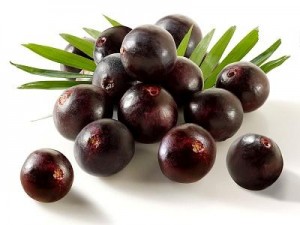The acai berry is an inch-long reddish, purple fruit . It comes from the acai palm tree (Euterpe oleracea) native to tropical Central and South America and has been a traditional food of the native people of the Amazon for hundreds of years. Acai derives from a word of indigenous peoples of South America meaning "fruit that cries." The fruit is used as a natural ink or dye and the wood is used in house construction (palm thatched roofs). Ethnobotanists have recorded no less than 22 different uses for all parts of the Acai tree. Due to what is being called the 'acai craze' in the United States, one proposed project in Brazil has called for the planting of five billion acai trees in the next 10 years.
How does it work?
The acai berry has been shown to contain a number of antioxidants (3) , including anthocyanins (4) which may boost the skin's ability to prevent oxidants from harming connective tissues. It also contains phytosterols which may protect epidermal collagen, and flavonoids, which may exert anti-inflammatory properties. omega-6 and omega-9 fatty acids, which are vital to proper cell contraction and regeneration; monounsaturated oleic acid, which may help the body to absorb omega-3 oil through the cell membrane more effectively; as well as phytonutrients and minerals such as potassium, iron, phosphorus and calcium. Acai berry purportedly posseses more proteins than an egg, and the vitamins B1, B2, B3, C and E. The oleic acid content of açaí has been reported to be the same as in olive oil.
What do we use it for?
In recent times, research on acai fruit has been centered on its potential antioxidant properties. Acai fruit has also shown anticancer (1) and anti-inflammatory activity (2)diseases casued by oxidative damage such as heart disease. It has also been used as immune stimulant, energy enhancer. Anthocyanins and flavonoids found in Acai fruit are powerful antioxidants that help defend the body against life's stressors. They also play a role in the body's cell protection system. Free radicals are harmful byproducts produced by the body. Eating a diet rich in antioxidants may interfere with aging and the disease process by neutralizing free radicals. By lessening the destructive power of free radicals, antioxidants may help reduce the risk of some diseases, such as heart disease and cancer. Some studies state that the antioxidant capability of the acai fruit is even greater than that of cranberry, raspberry, blackberry, strawberry, or blueberry. It has been reported that the antioxidant properties of Acai berries may also be effective at promoting weight loss although further research is still needed to confirm this.
How should we take it?
No typical dose has been set for acai berry as yet but effective doses appear to be 2000mg of whole acai berry. No contraindications are known.
Refs:
1. Pozo-Insfran, D., Percival, S. S., and Talcott, S. T. Acai (Euterpe oleracea Mart.) polyphenolics in their glycoside and aglycone forms induce apoptosis of HL-60 leukemia cells. J Agric.Food Chem 2-22-2006;54(4):1222-1229.
2. Schauss, A. G., Wu, X., Prior, R. L., Ou, B., Huang, D., Owens, J., Agarwal, A., Jensen, G. S., Hart, A. N., and Shanbrom, E. Antioxidant capacity and other bioactivities of the freeze-dried Amazonian palm berry, Euterpe oleraceae mart. (acai). J Agric.Food Chem 11-1-2006;54(22):8604-8610.
- Jensen, G. S., Wu, X., Patterson, K. M., Barnes, J., Carter, S. G., Scherwitz, L., Beaman, R., Endres, J. R., and Schauss, A. G. In vitro and in vivo antioxidant and anti-inflammatory capacities of an antioxidant-rich fruit and berry juice blend. Results of a pilot and randomized, double-blinded, placebo-controlled, crossover study. J.Agric.Food Chem. 9-24-2008;56(18):8326-8333.
- Rodrigues, R. B., Lichtenthaler, R., Zimmermann, B. F., Papagiannopoulos, M., Fabricius, H., Marx, F., Maia, J. G., and Almeida, O. Total oxidant scavenging capacity of Euterpe oleracea Mart. (acai) seeds and identification of their polyphenolic compounds. J.Agric.Food Chem. 6-14-2006;54(12):4162-4167.









